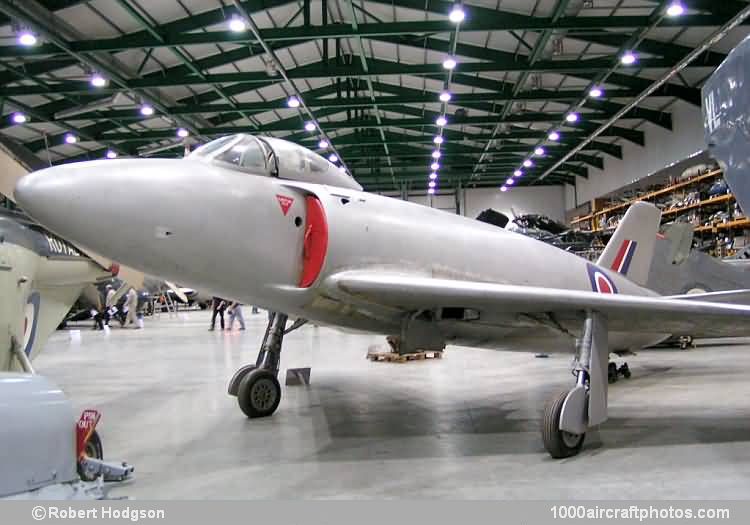08/31/2012. Remarks by Johan Visschedijk: "During 1946 the British Air Staff, perhaps realizing how far behind they were in experience with high-speed jet aircraft, issued advanced specifications for heavy bombers and for two-seat and single-seat fighters. One of the single-seat fighters was the E.41/46, a developed version of the Attacker with swept-back wings to serve as a Gloster Meteor replacement.
Two Supermarine Type 510 prototypes were ordered, serialed VV106 and VV119, both being built at Hursley Park and each fitted with a Rolls-Royce Nene 2 engine. The fuselages were Attacker-type with tail wheel but with wings and tail planes swept back to an angle of 40°. VV106 was first flown by Supermarine Chief Test Pilot M.J. Lithgow on December 29, 1948, from Boscombe Down. It was the first British jet-engined aeroplane to fly with sweepback on both wing and horizontal tail surfaces.
Testing was terminated temporarily by a wheels-up landing by Lithgow on 16 March, 1949, but was resumed again after repair on 10 May. For most of the initial trials the nose was rounded, but later a pointed nose gave increased speed, a nose pitot head was fitted and the aeroplane painted. During the early trials the cockpit hood was lost in flight after which the hood jettison mechanism was modified. The new type was demonstrated at the 1949 SBAC Display in September 1949, and by November it was nicknamed "Swift". (The name Swift was officially given to production version Type 541.)
Following modifications and adaptation for a naval role, the Type 510 was first flown, as such, by Lithgow, on September 14, 1950, in preparation for deck-landing trials and evaluation of a naval swept-wing fighter and was delivered to Farnborough on September 20 by Supermarine pilot L.R. Colquhoun. There it underwent airfield dummy deck-landing tests and measured take off performance inc1uding rocket-assisted take off exercises.
On 8 November, 1950, the Type 510 VV106, flown by Lt J. Elliot RN, became the first swept-winged aircraft to land on and take off from an aircraft carrier, in this case HMS Illustrious, and twelve landings and rocket-assisted take offs were achieved on that day.
The Type 510 later returned to the RAE for further tests and then to Supermarine for extensive modifications, including the removal of all naval equipment. Subsequently VV106 was modified to the Type 517, fitted with an unusual rear-fuselage, the whole of which was hinged to rotate in the vertical plane, adjustable up and down through 4° either way. During test flying, this variable incidence tail fitted to Type 517 proved to be a powerful and effective trimmer under all conditions of flight.
Pilots of the RAE Farnborough who flew the Type 510 in the new configuration liked its improved handling characteristics. One of these pilots, T. Gordon Innes, who was flying it on November 14, 1952, had an landing gear failure and made a successful wheels-up landing at Farnborough. The aircraft was repaired and flown again by Dave Morgan of Supermarine on September 2, 1953. Its flying career ended on January 14, 1955, when it was allotted to RAF Melksham as an instructional airframe, presently it is at the FAA Museum in Yeovilton, UK.
The second prototype, VV119, was externally similar to VV106 and, as the Type 528, was first flown by Lithgow on March 27, 1950, at Boscombe Down. Before this aeroplane could do much flying it was grounded in May 1950 for extensive modifications, the most noticeable being the change to a nose wheel layout after which it became known as the Type 535."
